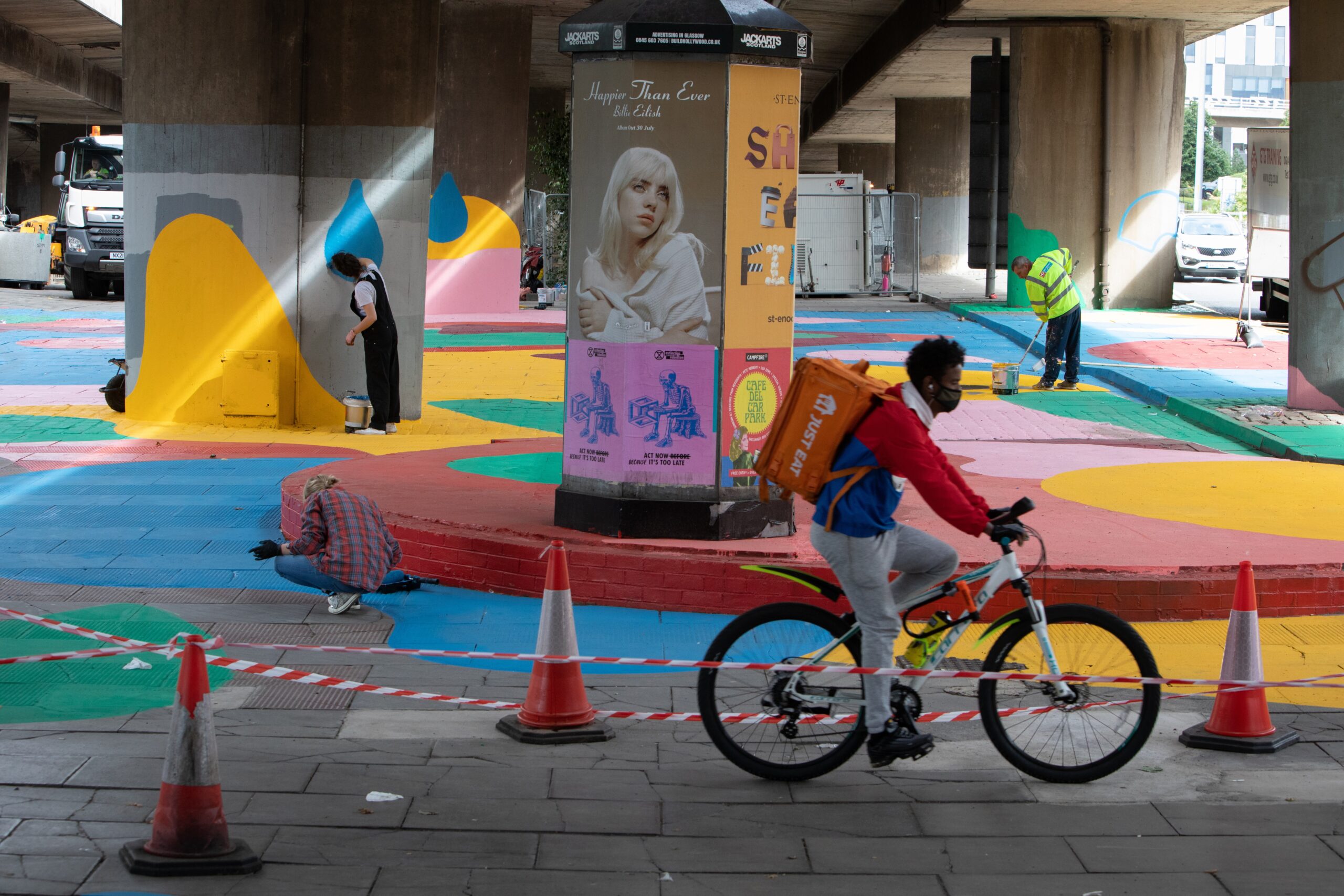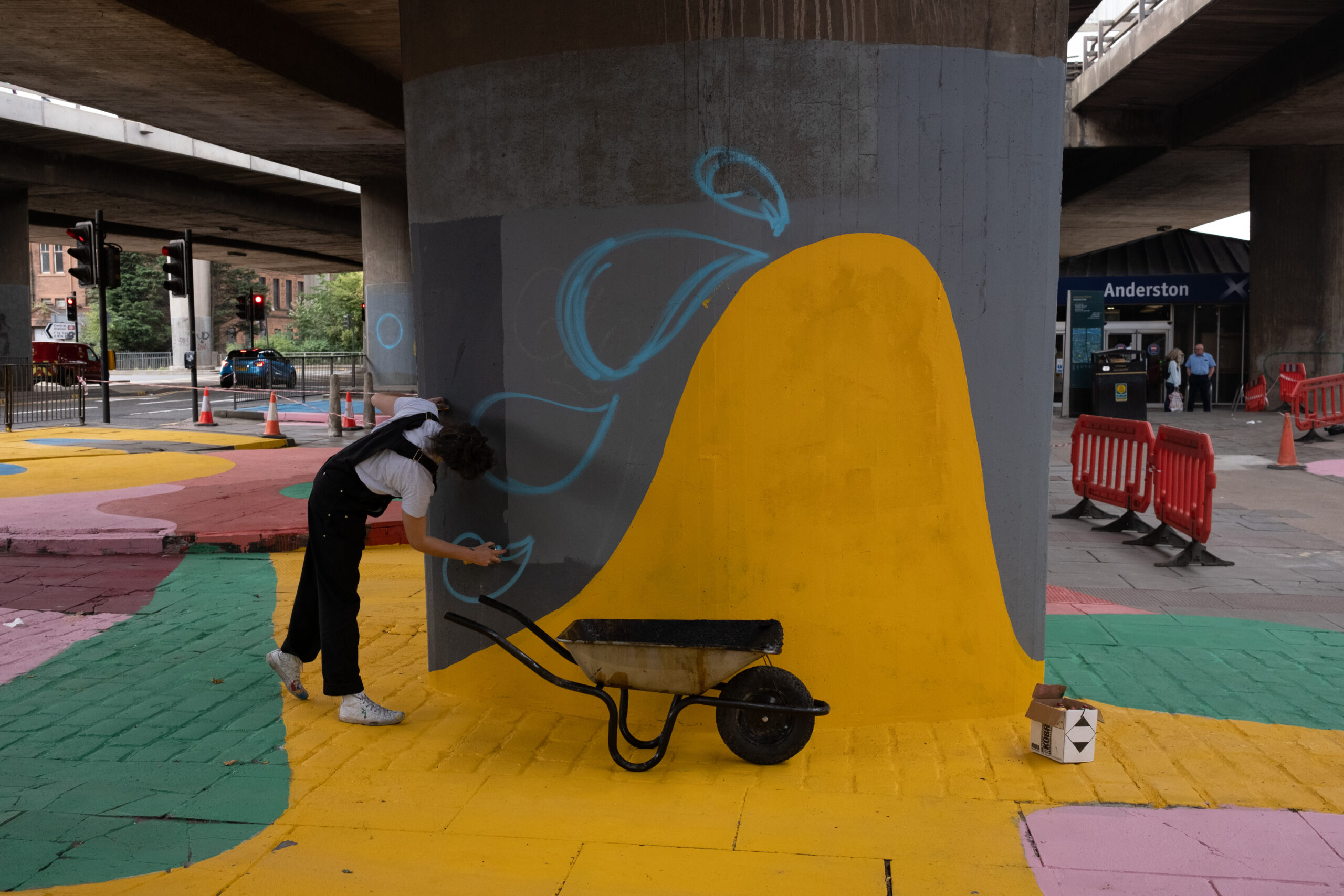A new work of art has been created in Glasgow – at a train station.
In the coming weeks, travellers through Anderston Station will be greeted with a new piece of artwork more commonly seen in US cities.
In the shadow of the Kingston Bridge on a traffic island in the middle of a busy road junction, Anderston Station entrance is undergoing a quiet facelift. Recent visitors may have noticed a splash of colour as a new striking design has appeared at the entrance of this important thoroughfare, in addition to some new greenery and benches.
With less than 50 days until the landmark Conference of the Parties (COP26) climate summit, Glasgow City Council is collaborating with Bloomberg Philanthropies to help deliver a legacy for the city and its residents. Starting with an innovative Asphalt Art installation at the entrance of Anderston Station, Glasgow joins a select group of international cities supported by Bloomberg Philanthropies to transform and revitalise public spaces through the power of art.
As one of the first cities in the UK to apply for the US Asphalt Art Initiative grants by Bloomberg Philanthropies, Glasgow City Council is using art and community engagement to improve street safety, revitalise public space and engage local communities.
The Asphalt Art Initiative is responding to the growing number of cities around the world embracing art as an effective and relatively low-cost strategy to activate their streets, with interventions on plazas and pavements, crossings and intersections and other transportation infrastructure. The grant programme is designed not just to create vibrant new public spaces but also to build city capacity for working with local artists and community groups on projects involving transportation infrastructure.

The Asphalt Art project in Glasgow
The opportunity and benefits of improving the area were identified as part of the council’s City Centre Strategy and District Regeneration Plans, creating an opportunity to work with Bloomberg Philanthropies. Marrying public safety with public art, the programme provides cities with funding to transform unsightly streetscapes with community-involved design projects.
The design team led by Civic Engineers and designer Gabriella Marcella have worked to improve the connection to and from the city centre. The striking design, developed by Gabriella, was influenced by the introduction of an experimental raingarden on the site. As an attractive way to reduce flood risk and treat surface water runoff from the nearby M8, raingardens provide additional biodiversity and a greater sense of place to city centre streetscapes.
Deputy Leader of Glasgow City Council, Cllr David McDonald, said: ‘The council has been delighted to partner with the prestigious Bloomberg Philanthropies on our journey towards COP26. We’ve engaged in a range of discussions on areas of shared interest about the environment, arts and culture, and community involvement.
‘One of the first fruits of this collaboration has been the innovative Asphalt Art installation, which puts Glasgow in a select group of cities supported by Bloomberg to transform and revitalise a public space through the power of art.
‘There are other projects underway which will be revealed soon, with Glasgow also benefitting from connecting with some of the world’s biggest cities in the run up to and during COP through the C40 network, of which Michael Bloomberg is president. This partnership work is a direct benefit of our host city role and is already delivering a legacy for Glasgow and Glaswegians.’

Asphalt Art project, with art design by Gabriella Marcella, was commissioned by Bloomberg Philanthropies in New York
Michael R. Bloomberg, founder of Bloomberg Philanthropies said: ‘Asphalt Art Projects can help cities rebuild from the pandemic by reinvigorating streets and making them safer, while also lifting spirits. As we’ve seen through our work in cities around the world, vibrant public artwork and smarter street design can inspire residents, build relationships between artists and the community, and help cities recover stronger than before.’
Designer Gabriella Marcella said: ‘I’m delighted that the project is in its final stages, and the public have been able to see our work progress in real-time. It’s been a challenging site to work across, but the giant graphics and colour have prevailed!
‘I hope the finished work brings a smile to people’s faces as they pass by, and encourages thoughts around water, and how we might rethink our relationship to it in our wonderful, and sometimes rainy, city!’
Meanwhile, around Anderston Station, it is hoped the completion of the artwork, addition of benches and raingardens will provide cheer to passengers and local alike as the city continues to re-open and recover from the pandemic.
TAGS

